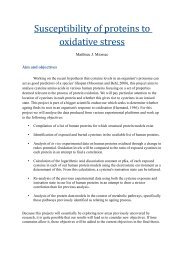Retinal Prosthesis Dissertation - Student Home Pages
Retinal Prosthesis Dissertation - Student Home Pages
Retinal Prosthesis Dissertation - Student Home Pages
You also want an ePaper? Increase the reach of your titles
YUMPU automatically turns print PDFs into web optimized ePapers that Google loves.
5.8.2 Electrode size and positioning in current retinal<br />
approaches<br />
The diameter of implanted electrodes in current retinal approaches [88, 103, 209,<br />
210] previous to 2007 has been of an order of magnitude of > 50µm. During 2007 it<br />
was determined that a change in electrode-retina distance of 100µm can result in a<br />
ten times change in threshold stimulation and also early results in the Second Sight<br />
device (epiretinal) in Humans showed an inverse square relationship between<br />
impedance and retina-electrode distance [210]. Clinical trials also began on the<br />
Second Sight Second-Generation implant at this time (www.2-sight.com) an earlier<br />
(2006) subretinal device [115] by Retina Implant GmbH and an a second clinical<br />
trial of an epiretinal device by Intelligent Medical Implants AG. In this reference it<br />
was pointed out that as an individual with 20/20 vision can resolve differences of<br />
1/60 of one degree of visual angle that this would translate to 5µm on the retina<br />
implying that 5µm electrodes would be needed for vision at this level. An estimate<br />
was also that a 100µm electrode could provide vision equivalent to 20/400 acuity. In<br />
2008 [176] the EPI-RET-3 prosthesis subsequently had 3D-electrodes with a<br />
diameter of 100µm and a height of 25µm.<br />
5.8.3 Recent developments<br />
2010 to now (2012) has seen a resurgence of work in this area; subretinally [23] the<br />
use of a parylene-based 3-D microelectrode array (MEA) demonstrated in vitro and<br />
in vivo how distance between the stimulating electrode (Ti/Au/Pt) and targeted cells<br />
could be decreased by the use of the tip shaped electrodes as opposed to nearly flat<br />
planar electrodes. Epiretinally [102] an in vivo study indicates smaller current<br />
thresholds; ≈100µA than previous thresholds; 500µA. Also [97] the possibility of<br />
lower stimulus voltage for 3-D electrodes as opposed to flat planar electrodes. The<br />
latest penetrating array for epiretinal prosthesis [29] makes possible high density<br />
arrays (≈100 electrodes/mm 2 ) and arrays of 2µm, 5µm, 10µm, 20µm and 30µm<br />
diameter with heights of 60µm-100µm and pitches of 50µm-400µm.<br />
104 of 200
















